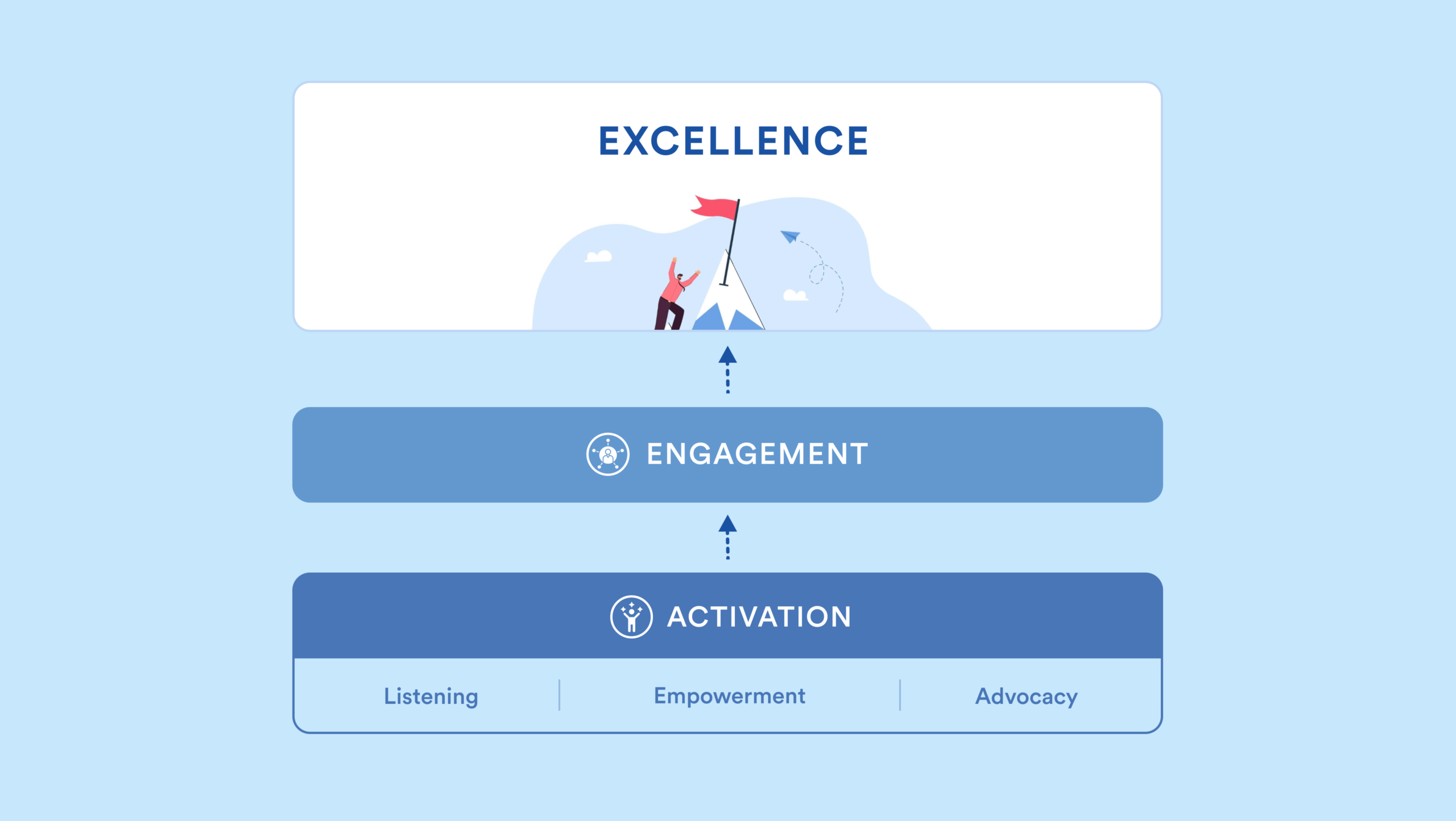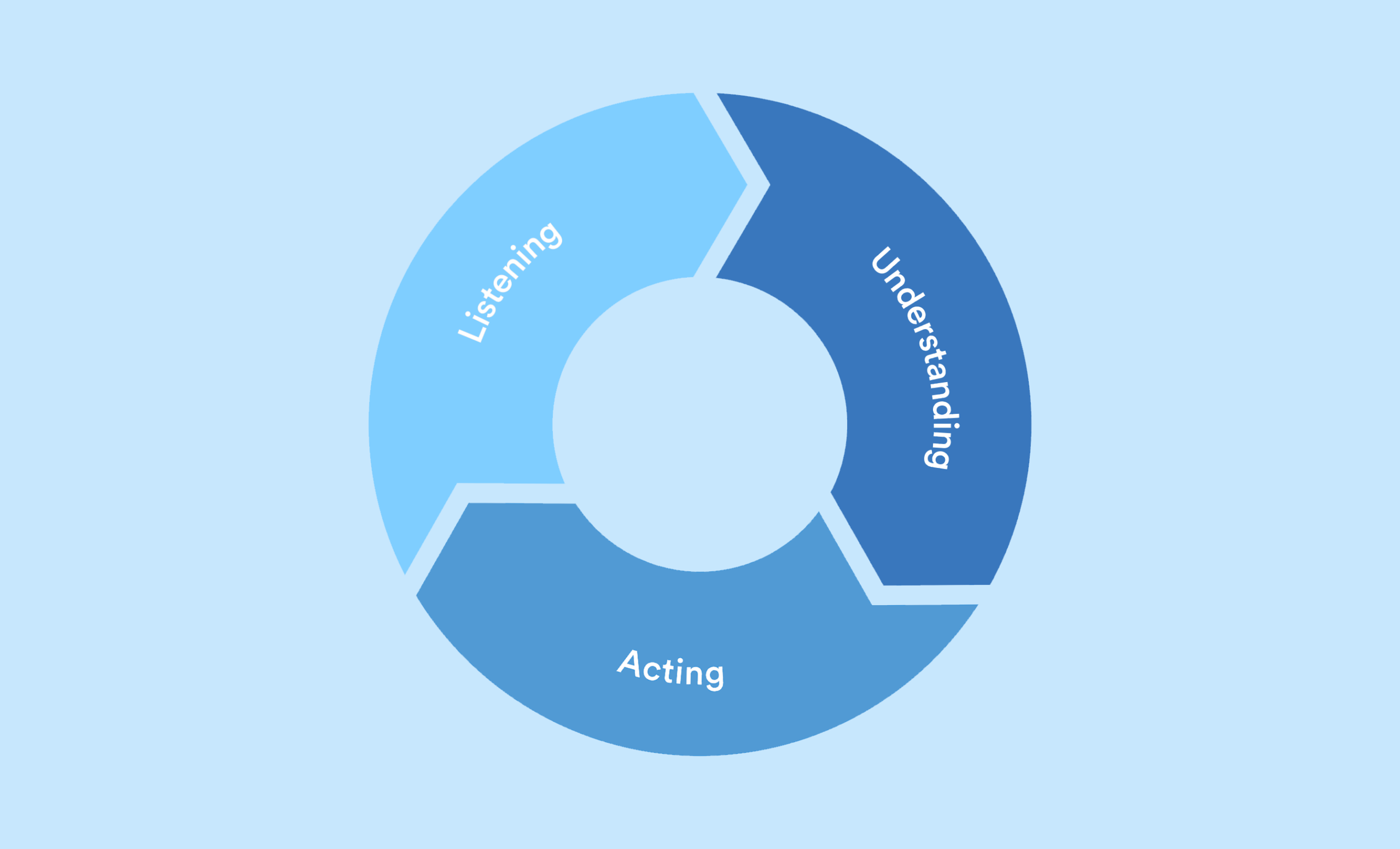What is employee activation, why does it matter now, and how you can you support it in your organization? Discover all the answers in this article.
Employee activation is tipped set top-performing organizations apart. It’s not quite listening, or empowerment, or advocacy, but a propulsive combination that puts workers at the helm of company culture, strategy, and reputation.
Today, just 22% of companies consider employee experience at all when designing work—even though it’s a force multiplier for customer and worker happiness as well as financial performance—and a paltry 10% involve their employees in organization and work design, according to recent research from the Josh Bersin Company.
Given this gap, setting your employee activation strategy now can put you ahead in an ever-tighter talent market.
How employee activation compares to employee engagement and advocacy

Employee engagement is the measure of your employees’ involvement and enthusiasm in their work and your organization—and it can make or break myriad crucial business goals, including customer loyalty, retention, productivity, and profitability, Gallup says.
In employee activation,your employees become catalysts of company culture, strategy, and reputation through your systematic collection, synthesis, and application of their insight and enthusiasm. It’s a propulsive combination of listening, empowerment, and advocacy that’ll mark the future of an engaged workforce and a peerless employee experience.
Get the guide! Beyond engagement: Employee activation
Employee advocacy is your employees’ promotion of your company and/or its offerings through word of mouth, social media, or other channels. Advocacy can be organic or strategically cultivated, and figuring out how to do the latter can be powerful, as employees trust their coworkers more than any group of leaders within the organization, according to Edelman’s research.
Shape your employee activation strategy

Research shows that organizations thrive when their employees have the space to share, be understood, and see action taken based on their feedback. So successful employee activation programs will incorporate these elements into a flywheel of continuous momentum:
Let’s dig a little deeper into each element.
Listening
Employee listening, also called continuous listening, involves the ongoing capture, analysis, and actioning of employee sentiment.
An evolution of the annual survey, it typically combines broad, quick-hit pulse checks at frequent intervals, such as monthly or weekly, with more targeted outreach at key milestones, such as someone joining or leaving, or the organization itself shifting course.
In short, it’s how you tap into how your people are doing, individually and collectively, so you can respond in smart and helpful ways.
This practice can also boost goodwill and the bottom line. According to The Workforce Institute at UKG, 74% of employees say they’re more effective and engaged when they feel heard. And yet it’s an experience that’s far too rare: Only 30% of U.S. employees strongly believe that their opinions count at work, Gallup says.
An employee activation strategy can help systematize listening efforts so your people can see that their input is valued. When shaping this dimension, consider:
- Your objectives: What’s your “why” for listening? What are you trying to accomplish with each component activity? At McKinsey & Company, for example, focused listening has produced actionable insight into how to improve inclusion, childcare and mental health benefits, connection for remote and hybrid workers, professional development, and more.
- Your audience(s): When, how, and why are you tailoring activities by dimensions like team, role, and tenure? Consider tools like audience maps and communication cascades to guide your choices.
- Your commitments: What’s in it for contributors? How will you protect their privacy and confidentiality? How will you share and use their collective input?
- Your channels and formats: How will you reach people with different preferences for sharing their thoughts? Consider, for example, which of the following will appeal to your people: surveys, town halls, employee resource groups (ERG), focus groups, individual conversations, and/or social listening (e.g., on external platforms and internal ones like those offered by your intranet software).
- Your cadence: How will you tailor timing by type of listening activity? By audience and goal? Be sure you’re not inundating any one group.
- Your questions: Are they as clear, concise, and relevant as possible?
- Your resource needs: Who should be involved in the asking? How much time, money, and lift will the effort require? Will any special technology or tools be involved?
- Your success criteria: How will you measure and track outcomes? Who will be responsible for delivering and reporting results?
Then, make it sticky and scalable.
One company transformed its notoriously “brutal” culture by systematizing their listening approach, recalled Jamil Zaki, author of The War for Kindness, in a recent conversation with McKinsey. “So this organization implemented a much more full-spectrum and frequent pulse survey of its people, gauging how folks were feeling, what they needed, what they were struggling with. And they showed concrete support and responsiveness.”
Understanding
A robust listening strategy will produce a multitude of insights stratified by channel, team, role, and more, so you’ll need to know how to slice, dice, synthesize, and distill all that data into meaningful action that shows you’ve taken what your people have said to heart.
And that requires some serious EQ.
Enter empathy. It’s an umbrella term for the ways we connect with other people’s emotions, and Zaki calls out one type that’s particularly helpful in the workplace: empathetic concern, or compassion. It involves feeling and expressing genuine care for what someone else is going through without taking on their pain (and risking burnout).
Get the guide! Beyond engagement: Employee activation
Despite the stereotype that empathy is too “soft and squishy” for a place of business, decades of research show it’s actually “a workplace superpower,” Zaki says.
“When people feel connected to their colleagues and to their leaders, they work harder, faster, and more creatively,” he explains. They also tend to call out less often with stress-related sickness and express more intent to stick around.
To cultivate it, he recommends managers spend dedicated time connecting with people and asking more or better questions—a practice that’s too often overlooked in the “quest for efficiency.”
But the two objectives don’t have to be at odds. The right tools can enable empathy at scale by removing barriers like time pressure, which has been shown to decrease empathy, and compassion fatigue, which can come from too much ad hoc or unguided listening.
As an example, McKinsey’s people analytics team built a self-serve portal that allows managers to tap into their team’s weekly pulse survey data. The reports can be filtered by date, population, and other characteristics, as well as compared with longitudinal data to guide decisions.
Acting
According to Zaki, empathy (a largely internal experience) should translate to kindness (an external behavior). In other words, listening on its own isn’t enough; you must be poised to act on findings.
And this is where most employers struggle: Only 18% of U.S. employees say their company is agile, according to Gallup. “Agility is more than an approach to work. It’s a way of experiencing work,” and it demands a culture that prioritizes, among other things, cooperation, empowerment, and knowledge sharing.
Get the guide! Beyond engagement: Employee activation
Here are some ways to make change—in good time and at scale—based on what you’re hearing:
- Enlist the C-suite: Because employees often enjoy little facetime with senior leaders, ensure your employee activation efforts bridge the gap. Tap the C-suite for listening and response activities by having members (or their internal comms ghost writers) lead targeted outreach efforts, as well as post regular blogs, vlogs, and social activity on your intranet. Don’t underestimate the value and power of simple likes, shares, or comments. When people see those at the top being involved or engaging with them, it incentivizes everyone to follow suit.
- Reward good behavior…: According to Gallup’s employee engagement research, one of the hardest statements for an employee to strongly agree with is, “In the past seven days, I have received praise or recognition for doing good work.” And yet, Josh Bersin’s research shows that “an organizational focus on fair and equitable rewards is one of the biggest drivers of overall outcomes.” So don’t skimp on it. And don’t forget to reward good citizenship as much as you do good work, Zaki says. “Call that out in a positive way, emphasizing empathic behavior and helping it to become normal behavior.”
- …So you can also hold people to account: Accountability is essential to organizational design, according to Josh Bersin’s research. You can apply this same principle to employee activation: Identify who’s responsible for carrying out a specific response to a listening finding, what the accountable party will do to drive outcomes, and how you’ll celebrate success. It’s the surest way to see real gains. “Accountability without rewards will fall flat, and not rewarding outcomes may be perceived as unfair,” Bersin says.
- Rally your superfans: Find those employees who take an active lead in your ERGs and social communities. If there’s a good place to begin activation efforts, it’s with them. Arm them with the encouragement, information, and tools they need to spread the good word internally and externally. More on that in the next section.
Enable employee activation at scale
Given the scope and scale of activation activities, finding the right technology to enable your strategy is essential.
Indeed, in the Josh Bersin Company’s research into employee experience, “advanced people analytics surfaced as the most important technology.”
Find an EX platform that amplifies and enhances your employees’ connection to each other, your leaders, and the organization at large. “Listening is not something confined to the employee experience function or the people analytics team,” Bersin says. “It spans every area of business and HR.”
When determining how best to power your employee activation strategy, here are some EX platform features to look for:
- Surveys and questionnaires
- Social features
- Ideas management
- Personalized content
- Advocacy tools
Let’s dig in.
Surveys and questionnaires
Paper surveys, physical suggestion boxes, and other types of questionnaires are a stalwart of feedback gathering, but their reach is limited in large, dispersed organizations. Online survey platforms have a wider wingspan and can complement traditional formats.
In addition to broad, quick-hit surveys at frequent intervals (e.g., monthly or weekly), consider more targeted outreach at key milestones, such as:
- Someone joining, departing, or celebrating an anniversary with your organization
- Someone stepping into a new, expanded, or more advanced role
- A team kicking off or wrapping up a project
- The organization restructuring or changing course
- External factors and macro forces, such as geopolitical conflict or climate events, impacting employees’ lives at work and home
To hold interest and encourage response, use a variety of question types (e.g., multiple choice, Likert, and free text), and mix up survey formats. Continuous surveys, for example, can run in the background and be pushed to employees at the right point in their journey, such as during onboarding or offboarding, while an eNPS can be part of your annual process to get broad consensus on how you’re doing.
Get the guide! Beyond engagement: Employee activation
Pulse surveys, meanwhile, can be deployed frequently—weekly or monthly—to get a temperature check on anything from morale to manager performance. The key is to make them quick, transparent, and actionable.
As an example, a dedicated people team at McKinsey combines answers to pulse surveys with employee information, anonymizes them, and synthesizes findings by role, tenure, geographic location, and/or other dimensions as relevant. “Results are shared with employees weekly, reiterating how their contributions can help leaders identify and shape changes and reinforcing the shared responsibility of colleagues at all levels of the organization to monitor and improve the culture,” the organization explains.
This transparency has been a powerful driver of participation: Within three years of launch, the pulse survey drew upward of one million responses from more than 40,000 employees across 140 offices around the world, representing feedback from more than 90% of the firm’s employees.
Social features
Social activation and listening come to us from the world of marketing. Companies use tools such as Hootsuite when they want to monitor public social media conversations about their brand, its competitors, and the shape of the market more broadly.
You can use a similar approach internally. Consider opening up—and tapping into—the following social intranet features:
- Forums or discussion boards: Use them to generate discussions and give employees a place to talk about specific themes or challenges. Beyond encouraging shop talk, consider creating space for connection over shared interests, such as a forum dedicated to dog owners or a specific hobby. The chance to bond with dispersed colleagues may lead to the emergence of internal influencers who can help others by answering questions and generating more discussions.
- Social media functionality: True engagement comes when people get a place to add their opinions. @mentioning, #hashtagging, image-friendly newsfeeds, forums, commenting, sharing, and gamification options are all effective ways to get people active in your digital workplace. Consider launching mini-campaigns to encourage your people to post, like, and share their peers’ posts. This gives a boost to contributors and generates important conversations and connections.
- Recognition programs: One of the most consistently popular and well-used aspects of Interact’s intranet is the rewards and recognition feature, which allows people to dole out points as thanks or recognition for anything from providing support on a project to resolving a customer issue. Recipients can redeem points for a range of rewards, including gifts and distinction as “employee of the year” or a champion of company values. It’s quick, simple, and plays a huge role in boosting morale and citizenship. It also makes the intranet social and engaging so that people come back and are continually exposed to news and updates when they do.
Idea management
Idea management involves crowdsourcing employee ideas and then managing them at scale through a dedicated platform.
On the backend, this may involve a dashboard that gives the leaders of a listening initiative an aerial overview of the conversations going on across a business. This can help you identify your superusers and superfans, popular ways of engaging, and hot topics to build future campaigns and cascades around.
Idea management can play a vital role in your employee activation strategy by systematizing your approach to synthesizing input and translating it to action.
Here are some best practices to keep in mind:
- Break up innovation generation into specific campaigns. Request ideas on customers one month and productivity the next.
- Gamify the process by creating leaderboards and rewarding those who submit ideas that are subsequently implemented.
- Make idea management part of your other listening efforts. Pulse surveys, in-person meetings, and idea gathering can all have a place.
- Ask different questions for various groups. Not everyone will deal with customers so they will have less ideas. Give them the opportunity to contribute too.
- Integrate asks into the tools your people are already using. If your company uses an intranet or Microsoft Teams, make that the place employees can submit ideas so they don’t have to look elsewhere.
Personalized content
While there are some company-wide updates everyone must see, surplus digital noise is a major deterrent to engagement (and a major pain for internal comms teams).
Make your employee activation related shares as customized and compelling as possible with an EX or intranet platform that enables personalization. For example, profiles and past interactions can help pinpoint and push relevant news, announcements, and resources to everyone, as well as ensure content being created and shared by activated employees is reaching audiences interested in the subject matter.
Geofencing can further refine your location-specific content. By setting up a virtual perimeter around specific locations, each time an employee logs on to the intranet within that space, they only see content intended for them.
This is extremely effective in cases where individuals move frequently and require different content and documentation across locations (e.g., salespeople or senior leaders on location visits). This builds value for your people and helps them see your EX platform as a hub for connection with each other and your organization.
Advocacy tools
You can suss out your social-savvy superfans with features of platform’s front end and analytics suite, such as:
- User profiles of the employees that contribute and interact most with your intranet content
- Indicators like shares, comments, active forum membership, or blogging
- An “Influence Score” that an advanced intranet might create from aggregate data
Once you’ve spotted your superfans, look for built-in tools that can help amplify their reach:
- Content creation tools, such as an accessible CMS, that make blogging and sharing effortless
- Mobile-friendly design, such as an appthat allows your people to create on the go and at the precise moment inspiration strikes
- Social advocacy features that make it easy for employees to share insights, job openings, and other brand-building content to their external networks
Shape the future of EXcellence
Now more than ever, people want to see themselves, their values, and their voice woven into the fabric of work—and they’re not shy about looking elsewhere or airing grievances when employers fall short. Channel this energy for the common good by partnering with your employees to put forth an employee activation strategy that allows them to shape success. Because it’s your people who will power the future of work and a peerless employee experience.






